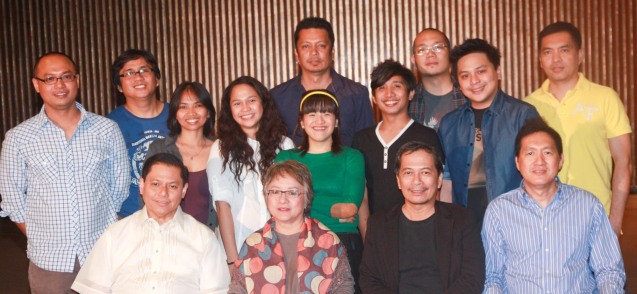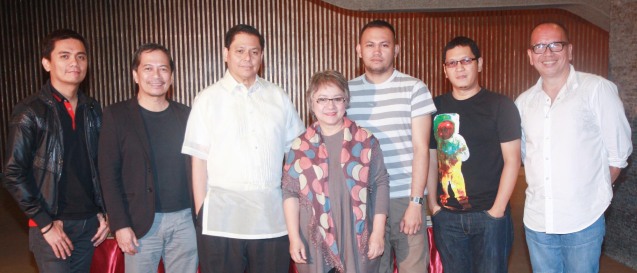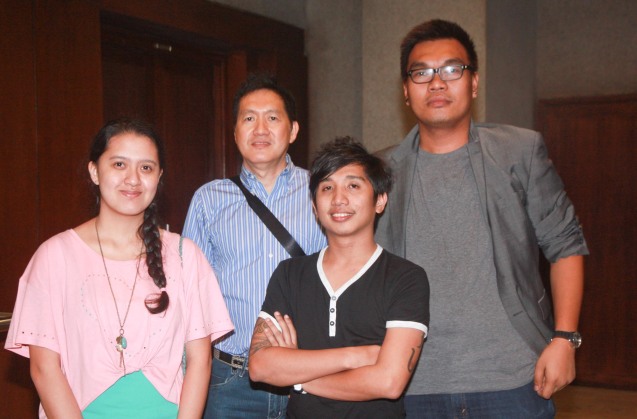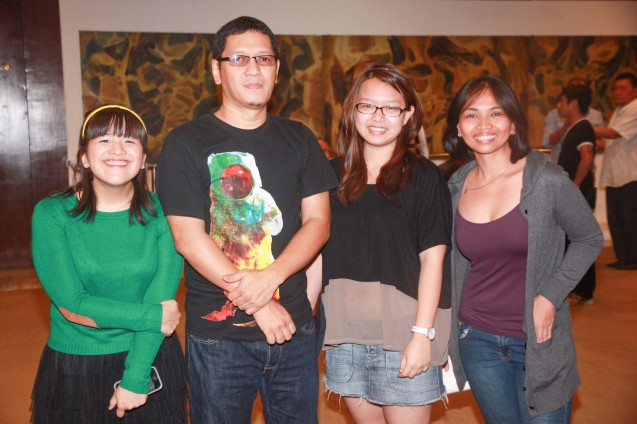
New Breed category standing from right: Aloy Adlawan “Ang Katiwala” (The Caretaker), Eduardo W. Roy “Lola Igna” , Paul Sta. Ana “Oros” , Emerson Reyes “MNL 143”, Emmanuel Q. Palo “Santa Nina”, Marie Jamora “Ang Nawawala” (What Isn't There), Ice Idanan “Mga Sulat Para Kay C”, Darlene Malimas “Apparition”, Mes De Guzman “Diablo” and Julius Sotomayor Cena“DAYO”. Seated from left: CCP Pres. Raul Sunico, Cinemalaya Competition Chairperson Laurice Guillen, Cinemalaya Foundation Head Nestor Jardin and Cinemalaya Monitoring Head Robbie Tan. Photo by Jude Bautista
Written and photographed
By Jude Thaddeus Bautista
The call for a boycott of Cinemalaya this year due to the disqualification of Emerson Reyes hurts not just the organization but also the 14 other filmmakers who are currently making their films. In the director’s showcase : “Bwakaw” by Jun Lana , “Kalayaan” (Wildlife) by Adolfo B. Alix Jr. , “Kamera Obskura” by Raymond Red , “Posas” by Lawrence Fajardo , “Mga Mumunting Lihim” by Jose Javier Reyes

Cinemalaya’s Director’s showcase category, from right: Jose Javier Reyes “Mga Mumunting Lihim”, Raymond Red “Kamera Obskura” , Adolf Alix Jr. “Kalayaan” (Wildlife), Cinemalaya Competition Chairperson Laurice Guillen, CCP Pres. Raul Sunico, Cinemalaya Foundation Head Nestor Jardin and Jun Lana “Bwakaw”. Photo by Jude Bautista
In the New Breed Category: “Ang Katiwala” (The Caretaker) by Aloy Adlawan , “Ang Nawawala” (What Isn’t There) by Marietta “Marie” Jamora , “Oros” by Paul Sta. Ana and Obet Villela , “Apparition” by Vincent Sandoval / Darlene Malimas , “DAYO” by Julius Sotomayor Cena , “Diablo” by Mes De Guzman , “Lola Igna” by Eduardo W. Roy Jr. , “REQUIEME” by Loy Arcenas , “Santa Nina” by Emmanuel Q. Palo
There is absolutely no doubt that it is painful and difficult for anyone to be disqualified for any reason. Does it justify ignoring the work of the other filmmakers? Definitely not. As painful as it is for Emerson Reyes, it’s not the end of the world for him. Pepe Diokno in his column suggested several film fests abroad where Reyes can still pitch his project. Locally, Cinema One has recently doubled the seed grant to 1 million pesos, if his project is picked up. I have faith in his abilities and creativity enough to know that he can still make it work. If he gets it done with his casting choice of Allan Paule and Joy Viado then he will already have had some measure of victory.

from right: MNL 143 Producer Nestor Abrogena, director Emerson Reyes, Cinemalaya Monitoring Head Robbie Tan. Photo by Jude Bautista
By all means we should all support “MNL 143” in the same way we should support the work of ALL Filipino independent filmmakers. At the same time, we should not in any way boycott and forget the other Cinemalaya filmmakers or the ones in CINEMANILA and Cinema ONE. OR even self-produced and any other kind of Filipino films for that matter.
Transcending a Film fest
You have to wonder why there is such a huge furor over Cinemalaya on the net. This is because it has already transcended the role of a mere film festival. In a way, it has become the voice of Filipinos through film, showing who we are, our culture, the current trends and way of life especially that of the youth. Through films like, “Engkwentro” by Pepe Diokno, “Pisay” by Auraeus Solito, “Amok” by Lawrence Fajardo, “Niño” by Loy Arceñas, “Tribu” By Jim Libiran and countless others too many to mention. They have all won acclaim abroad in one form or another carrying the Philippine flag. This has been happening consistently over the past 7 years.

New Breed category standing from right: Aloy Adlawan “Ang Katiwala” (The Caretaker), Emerson Reyes “MNL 143”, Julius Sotomayor Cena“DAYO”, Paul Sta. Ana “Oros”, Eduardo W. Roy “Lola Igna” , Marie Jamora “Ang Nawawala” (What Isn't There), Loy Arceñas “Requieme”, Darlene Malimas “Apparition” and Emmanuel Q. Palo “Santa Nina”. Seated from right: Cinemalaya Competition Chairperson Laurice Guillen, Mes De Guzman “Diablo”, Ice Idanan “Mga Sulat Para Kay C” and Cinemalaya Foundation Head Nestor Jardin. Photo by Jude Bautista
That’s why Filipinos naturally feel that it IS the national film fest that will again put our country on the map in the realm of filmmaking. It has also created a large audience to the tune of 40-45,000 of last count, where previously there were extremely limited viewers for indie film. As Filipinos we feel we ALL have a stake in Cinemalaya. In reality it is a foundation that is privately funded. The most consistent and major donor if you will is Tony Boy Cojuangco.
The fact that a private foundation has functioned and succeeded in this manner to be considered as a national institution is already a tremendous achievement that can never be overstated. Again, one of the suggestions on the net is to have the government handle a Cinemalaya type body. Good luck with that. It will be riddled with the same problems from national government: lack of funds, inefficiency, bureaucratic red tape, corruption, etc. etc. PNoy is trying to rectify that, as of now it stands as the rule rather than the exception.

Seated from left: Cinemalaya Foundation Head Nestor Jardin, Raymond Red “Kamera Obskura”, Jose Javier Reyes “Mga Mumunting Lihim” and Cinemalaya Competition Chairperson Laurice Guillen. Standing from left: Adolf Alix Jr. “Kalayaan” (Wildlife), Jun Lana “Bwakaw” . Photo by Jude Bautista
Journalistic Hierarchy and Film’s Collaborative Nature
The bottom line of the issue between Reyes is the casting of Allan Paule and Joy Viado for their roles, to which both Robbie Tan as Festival Monitoring Head and Laurice Guillen Competition Chairperson disagreed. Tan later clarified his position in PEP.ph, saying that he was not against the actors individually but more of the combination of the two. Whether or not you agree with the outcome both Tan and Guillen have made the decision to disqualify Reyes as part of the functions of their job. There were never any personal or financial vendettas here only an honest assessment of the situation and the application of rules of what is essentially a private organization.
As a journalist who has worked for and dealt with newspapers and publications, there is one constant rule: editorial prerogative. Even as a writer having the byline on a newspaper or magazine I am NOT the final word on what gets published, hardly. The Section Editor gets to decide what corrections are made AFTER the proofreader has gone through it. Even they are answerable to the Editor in Chief or also in my case, the photo editor also has his say.
Section Editor actually gets to decide IF at ALL the article is published or NOT. Whatever they do to it is their call. That’s what editorial prerogative is. This is for one measly article for a daily. My bosses, my former bosses are ALL there for a reason. They have more experience than I do. They’ve written far more articles than I have. They would not be in the position they are in if they weren’t qualified to do so. If my work as a journalist has been edited does it mean that my right to express myself or freedom of the press has been impeded? Obviously not.
All these checks and balances exist for one measly article in a newspaper. I’m not going to elaborate how influential or powerful articles can be. Recently, PDI Lifestyle Editor Thelma Sioson-San Juan wrote about the VERY painful and difficult daily corrections, verbal and what not that she received as a young journalist. PDI Publisher Isagani Yambot, who recently passed called it her ‘6 o’clock habit’

from left: Ang Nawawala director Marie Jamora, Kamera Obskura director Raymond Red, Ang Nawawala Producer Daphne Chiu and Darlene Malimas of “Apparition”
Thelma gave a very eloquent example of editorial prerogative especially in the life of Gani Yambot in her article “The Good Soldier”, “While many today know him as the publisher who was at the forefront of causes, we saw how he was early on—a good soldier who respected and followed the hierarchy of the newsroom. (Never a democracy.) Gani belonged to the generation of journalists who respected the authority of editors in the newsroom (in his case, it was Joe Luna; in our case, it was Gani’s batch). ‘When told to jump, don’t ask why; just ask, how high!’—that was ingrained in Gani’s breed.
Was it sheer blind obedience? Not really. It was more out of a sense of respect not only for the individual editor, but more so, for the years of professional expertise and wisdom that the position represented. It was born out of the desire to learn—and to pay one’s dues.”
IF there is a system of checks and balances for a mere article in a newspaper shouldn’t there be some system of ‘editorial prerogative’ in film? As an organization Cinemalaya thought of putting this very difficult task to Robbie Tan and Laurice Guillen. No matter what your opinion is on their body of work their experience cannot be denied. The disqualification of Emerson Reyes, however painful and difficult, was an exercise of THEIR editorial prerogative.
In a film, there is so much more at stake. There’s a collaborative nature in film, which well obviously has inputs from several people not just the director. In this case Reyes was working in the framework of not just funding but the whole process and system of Cinemalaya. It is extremely naïve and misinformed to believe that the director is the FINAL word in ALL aspects of the film especially in the case of a Cinemalaya entry. You’re not only carrying the name of your own film but that of the festival. Based on the success of Cinemalaya films abroad so far it’s a system that works.
Chemistry in the Romance Genre
The storyline of MNL 143 is based on an OFW who comes back in search of his childhood love. There’s a strong romance element to it. Both Alan Paule and Joy Viado are performers and actors who have proven themselves with their work. Joy has been cast in TV5’s “Bagets” and so many other movies and TV series. Alan Paule also has a long list of TV and film work such as “Mundo Man Ay Magunaw” in ABS CBN. The way that Tan explained it to Mell Navaro in the PEP.ph article, it was a question of the chemistry between the two as a couple that was very much in doubt.
In the romance genre at least chemistry between the lead actors is a must. The most recent example that comes to mind is “The Vow.” Rachel McAdams has been cast in arguably the most successful romance films the past years: “The Notebook”, “The Time Travelers Wife,” “Midnight in Paris.” She’s a guaranteed draw for romance films.
Paired with her for “The Vow” is Channing Tatum more known for the recent GI Joe films. On paper it looks like a good pairing. In reality the chemistry was far inferior than McAdam’s previous pairing with other leads such as Ryan Gosling and Eric Bana. Lisa Schwarzbaum of Entertainment Weekly echoed my own assessment: “The two stars look dewy and glossy and unexceptional, bound together less by chemistry than by the ministrations of a hard-working costume designer.”
It’s a lot less about their abilities as individual actors as it is being cast together in an onscreen relationship. Will it be believable? Will they have that elusive and almost impossible to define ‘chemistry’? Casting isn’t an exact science, so you have to take into account what you DO know about them. One of these is their previous work. Based on the experienced judgment of Robbie Tan there will be no onscreen chemistry between the two. He may have surmised that the bulk of Viado’s work has been in comedy and Paule actually started out and became famous with gay roles in “Macho Dancer” in 1988 and “The Masseur” in 2005.
Theoretically, ANY actor can inhabit any role and do well in it. But based on facts that you know and have there is NO hard evidence to support that they will have onscreen chemistry. Incidentally, Tan has worked as executive producer for the past 3 decades, including Brillante Mendoza’s “Foster Child” which has won awards at the Brisbane, Durban, Cinefan awards abroad. Locally it has reaped awards at FAMAS, Golden Screen, Gawad Urian and even the Young Critic’s Circle.
 This isn’t to say that Tan is infallible. What is sure is that his and Guillen’s decision was part of the system of checks and balances within Cinemalaya. Theoretically the director makes ALL of the creative decisions in the film. But based on the reality of having to manage, fund and create a real venue for Filipino independent film there has to be a certain amount of control for organizers. It is far from perfect but it doesn’t mean you have to malign, destroy and discredit Cinemalaya just because you disagree with its decision. There are a lot of other filmmakers who will be affected.
This isn’t to say that Tan is infallible. What is sure is that his and Guillen’s decision was part of the system of checks and balances within Cinemalaya. Theoretically the director makes ALL of the creative decisions in the film. But based on the reality of having to manage, fund and create a real venue for Filipino independent film there has to be a certain amount of control for organizers. It is far from perfect but it doesn’t mean you have to malign, destroy and discredit Cinemalaya just because you disagree with its decision. There are a lot of other filmmakers who will be affected.




